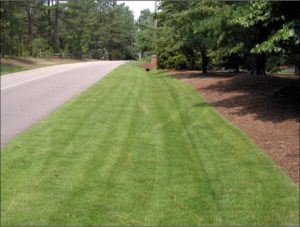Choosing the right grass for your lawn

Warm-season grasses are recommended for our area because they grow best in our climate.
WAYNE COUNTY — With warm, spring days now here, the thought of establishing a lawn often comes to mind.
With the decision to establish a lawn comes the decision of what type of grass to select. Since now would be the time to establish a new lawn, it is a good time to do some research for choosing the right grass for your lawn. There will not be one type of grass that is the best, instead it will be a personal preference of what grass characteristics one prefers.
First of all, what is the difference between cool-season and warm-season grasses? Cool-season grasses grow best in the spring and fall and are less active in the summer. Common types of cool-season grasses include fescues, bluegrasses and ryegrasses. Warm-season grasses are slow to green up in the spring, grow best in the summer and go dormant after the first heavy frost. Common types of warm-season grasses include Bermuda grass, zoyia grass, centipede grass and St. Augustine grass. Warm-season grasses are recommended for our area because they grow best in our climate and are best planted from March through July.
When selecting a type of lawn grass, you will want to compare and contrast the different types of warm-season grasses. The characteristics of your site, your goals and your intended use of the lawn will all determine which type of grass is appropriate for you. Where heavy traffic is expected, choose a tough, aggressive, wear-tolerant grass. Also, take into consideration the amount of time, effort and money you are willing to spend for turfgrass maintenance.
Warm-season grasses are recommended for our area because they grow best in our climate.
Bermuda grass is a popular low growing, dense grass that has medium color and texture. Bermuda grass requires full sunlight and does not grow well in shade. This grass type will grow well on all soils, especially sandy soils, and is very drought tolerant. The rate of establishment is fast and it can recover rapidly from injury. Bermuda grass can withstand wear and traffic well, however, it requires a high mowing frequency and it is recommended to be mowed at a short height of 0.75 to 1 inch. There are two types of Bermuda grass available, common and hybrid. Common Bermuda grass is more invasive into flower beds and other areas while hybrid Bermuda grasses such as Tifway and Tifgreen are not as aggressive growers.
Centipede grass is a light apple-green color, with coarse textured leafs. Centipede is a slow-growing grass, taking two to three years to fully establish. Centipede grass is low maintenance in that it requires less frequent mowing. Centipede grass grows well in full sun to moderate shade. Centipede grass can be a little picky because it does not tolerate several things such as traffic, soil compaction, heavy fertilization, excessive drought, high soil pH, common lawn herbicides, late spring frost or heavy shade. The recommended mowing height for centipede grass is one inch.
Zoyia grass is a slow growing grass with a medium to dark color and a fine to medium texture. Zoyia grass makes a very dense, wear-resistant lawn. It grows well in full sun or partial shade and is drought tolerant. Zoysia grass’s very dense nature can make it more prone to thatch build up, requiring dethatching every few years. Zoyia grass requires less mowing but, like Bermuda grass, it is mowed at a height of 0.75 to 1 inch.
St. Augustine grass is medium to dark green with coarse leaf texture. St. Augustine has poor cold tolerance, causing it to grow best in warm, humid areas that are not exposed to excessive or intense periods of cold weather. The “Raleigh” variety has the best cold tolerance and is best suited for the eastern piedmont and coastal plains. St. Augustine grass tends to be more expensive because it is not available in seed form and would have to be sodded. This grass type prefers fertile, well-drained soils. It has excellent tolerance to shade and heat and has some drought tolerance. St. Augustine grass does not tolerate heavy traffic and like centipede grass it is sensitive to common lawn herbicides. Since it is fast growing, St. Augustine needs to be mowed frequently. It is a taller grass with a mowing height of two to three inches.
When selecting the type of grass you want to grow, you have to consider the site along with your needs and interest. The same grass type will not be suitable for everyone. Not one grass type will be perfect for every situation, there may have to be some give and take on what you are willing to put up with from your lawn and what you are not willing to deal with. By taking the time to do some planning, you can end up with a lawn that you will enjoy.
— From the Wayne County Cooperative Extension website, by Extension Agent Jessica Strickland



